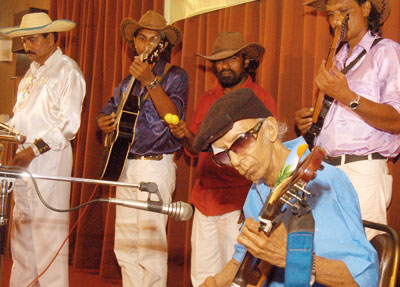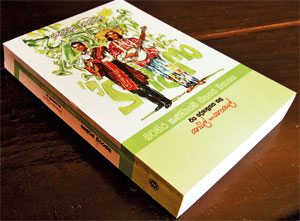They put a song and a dance to our music
View(s):Shelton Weeraratne’s book traces the work of Neville Fernando and Noel Ranasinghe who transformed Sinhala pop music, with their own brand of Baila
By Feizal Samath
It was a simple ceremony but a giant step towards explaining to Sri Lankans the history and origin of Sinhala vocal harmony and ballads.
The work of Neville Fernando and Noel Brian Ranasinghe, two musicians who transformed Sinhala pop music into a wonderful, catchy rhythm creating a new brand of music, and the musicians of that genre is captured in a delightful book by veteran lyricist and journalist Shelton Weeraratne.

Veteran musician Noel Brian Ranasinghe performs at the launch. Pix by Nilan Maligaspe
“There is no chief guest for this ceremony and I was asked why. I said this is because everyone is special,” explained Shelton during a simple launch on Wednesday at the Mahaweli Centre, of his book in Sinhala titled ‘Batahira Kandayam Sangeethaye Vikashaya- Eya Deshanugathakala Neville saha Noel’. It speaks, among other matters, of how Neville and Noel created a new brand of Sri Lankan music based on western influences and developments.
There were no frills, no glamorous 5-star banquet though a book of such historical importance deserves this, and just one half of the book – Noel – was present in the audience, for Neville Fernando, leader of the Los Caballeros, is no more.
Music wafted outside the halls of the auditorium as a ‘calypso’ band played popular favourites like ‘Malee – Ruvan Malee’ and ‘Gayana Gayum’ from probably two of Sri Lanka’s leading musicians, whose work is now captured in book form for generations to remember and follow.
Shelton’s labour of love took 13 years to complete and thus is a well-researched product. “Noel’s wife must have exclaimed in annoyance, ‘anna enawa, headache enawa’ or ‘onna Disprin enava’ during my countless number of visits to Noel’s Nugegoda residence,” he told the audience including Noel’s wife, Sriyani amidst laughter that echoed across the hall.
Noel and his band ‘La Ceylonians’ pioneered the sarong, shirt, straw hats and barefoot style drawing strange looks and catcalls but that eventually became a fashion and a music form over the years. His music was not calypso from the West Indies but that label was affixed to these balladeers in their strange-looking outfits and 6-8 rhythm, which was also how baila was played. Neville popularised Latin American rhythms and songs, studying and learning the language.
According to Noel, who fostered many a musician like Milton Mallawarachchi; wrote the evergreen ‘Hoiya’ and helped the Moonstones – lending his song Mango Nanda -, the rhythm evolved from temple drums.
The history of Sinhala pop is not the only contribution by Shelton to the literature on traditional music. When researching for the book, the veteran lyricist stumbled on unknown and unheard of music and dance forms relating to the baila. “This data is unbelievable,” he told me on an earlier occasion when I was writing a piece on the origins of the baila.

His search for background material revealed how the music form came from the Portuguese and the British who brought Boer prisoners to Ceylon during their respective periods as colonisers of the island to serve as jailors. Eventually, communities of these jailers, known as Kaffirs, settled in Puttalam, on the island’s northwestern coast, and in the eastern town of Batticaloa.
The music of the Kaffirs was heavily influenced by Portuguese and African forms, singing and dancing what is known as kaffrinja, the precursor to today’s baila.
According to some researchers, the origin of baila is also linked to the Muslim Moors in Spain (eventually extending to Portugal) when a dance form called bayle (pronounced bay-lay) evolved from Flamenco. Centuries later, bayle was to evolve into the baila of Sri Lanka.
Goa, with its rich Portuguese heritage, also has its own form of music called Konkani baila. The audience at Wednesday’s launch included many oriental and Sinhala pop musicians. Noel, who underwent brain surgery recently, thanked his wife, two daughters – Nelum and Nelushi -, and friends for their support during this difficult period.
Restricted in his singing, he however delighted the crowd with his usual brilliance on the banjo, playing 2-3 instrumentals. Neville and Noel belong to a genre where music was live, box guitars were not amplified and mike-less voices had to be heard across any hall. Such was the brilliance, creativity, versatility and skills of the musicians of yesteryear unlike today where musicians would be lost without electric guitars, mikes and copied backing tracks.
Shelton’s 544-page book has given a new lease of life to the popular music of the 1960s generation; it captures music across the world and should serve as a historical document of Sri Lankan music over the ages.
The legacy left by gentle giants like Neville and Noel must be supported by the state through a fund that would assist all musicians of that genre who are struggling, financially, after contributing so much to music and the progress of a nation.
Origins of the baila
The Sunday Times Business Club is planning to hold a symposium in June on the origins of the baila. The half-day event will include an academic discourse and a panel discussion tracing how baila has evolved over the ages even before the 1960s when a police constable and music enthusiast named Wally Bastian – widely regarded as the godfather of baila – introduced lyrics to some kaffrinja tunes popular at the time. Wally’s “Nurse Nona’ is still a popular hit.
Music and dance will also form part of the event. Anyone interested in being part of this event please write to the Business Editor, Sunday Times at bt@sundaytimes.wnl.lk
Follow @timesonlinelk
comments powered by Disqus


















